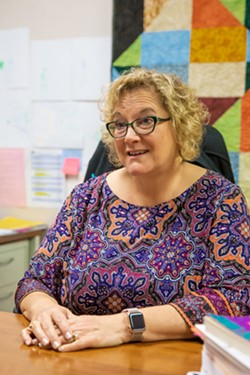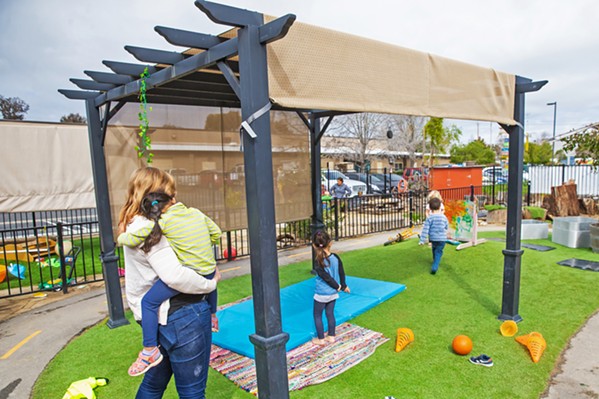The savvier of San Luis Obispo County parents know the game: When a mother-to-be finds out she's pregnant, one of the family's first moves—sometimes before even going to the doctor's office—is to sign up on a waiting list for child care.
Competition for a scarce number of slots is fierce. Provider options are limited. Waitlists are long. And the prospect of missing the boat is terrifying.
Sara Lopus had all this in mind two years ago when, as a new Cal Poly faculty member, she called up the ASI Children's Center to add her name to its list.

- Photos By Jayson Mellom
- CARE WANTED Nova, who attends the Cal Poly ASI Children's Center, appears intrigued by New Times photographer Jaysom Mellom. Infant care is an often unmet and rapidly growing need in SLO County.
"I'd heard the wait here on campus was long," Lopus told New Times. "So the day I found out I was pregnant, like before I saw my doctor, I got on the waitlist."
Though she was new to the Central Coast, Lopus wasn't new to finding child care. When she and her spouse previously lived in Northern California and the East Coast with their first child, Lopus found that if she planned far enough ahead, things worked out.
"I just imagined that it would be that way here," she said.
But SLO was different. When Lopus had her second baby, she called the center to confirm that a spot would open for her infant when she turned 4 months old. Not only did the center say "no," they told her it was unlikely a spot would open the following year.
"Now, we're waiting to hear if there'll be a spot for her when she's 2," Lopus said.
Tonya Iversen, who runs the ASI Children's Center, which is an infant care center and preschool for 130 university- and non-university-affiliated children ages 4 months to 6 years old, told New Times that her waitlist is longer today than it's been throughout her tenure there.
"I used to say it was about one year," Iversen said. "Now, the wait is getting up into the 2 1/2- to 3-year mark. Some families will put their names on the waiting list when their children are infants, and I may never get them into the program."
While taken aback by the news, Lopus at least had some prior experience with the child care crunch to lean on. For unwitting first-time parents, child care's inaccessibility and unaffordability can blindside them.
"I had no idea this was even an issue until I had a child," said Angela Clarke, a SLO resident with a 6-month-old infant. "I was thinking to myself, there's no way I'm not going to find a day care for her. I have four months to find it."
Clarke ran into waitlists and costs that shocked her.
"It's insane," she said. "I think the average [cost] is $1,200 to $1,500 per month, but not only that, there's a two-year waitlist for a lot of places."
Lopus' and Clarke's stories are indicative of how child care has become an increasingly difficult issue in SLO County. Professionals in the field say that as the cost of living in the area continues to rise, more and more two-parent families are relying on two full-time incomes to get by. That, in turn, has led to a swelling of need for pre-K care.
But finding it and affording it aren't easy. The predicament has added stress to parents' lives, forced employees out of the workforce, and even driven families to leave SLO County altogether, experts say.
"I hear desperation," Iversen said about parents, "and it's coming more and more frequently. Last week [in early March], I got an email from a woman who's been on the waiting list for almost three years. She and her husband are considering moving because they cannot find child care. ... I'd like to say that's just one person, but it's not. That's why I think this becomes an economic issue for the entire community."
Various community groups and businesses are starting to come together to talk about the question, "Where's the care?" Advocacy organizations like First 5 San Luis Obispo County and CAPSLO want to bring child care to the forefront of public conversation.
On Wednesday, May 29, those groups will host a public workshop, "Where's the Care? Tackling our Local Child Care Challenge," from 4:30 to 7:30 p.m. at Congregation Beth David. The town hall invites families, employers, civic leaders, educators, regional planners, students, and advocates to participate in a discussion about early child care and education issues in SLO County, including "the lack of accessibility and affordability for families, and a persistent workforce crisis in the early childhood education field," according to the town hall press release.
"We have been increasingly aware that it's time to elevate the conversation to a broader platform," said Wendy Wendt, the executive director of First 5 SLO County. "There's a real growing concern in the business community about what the system is able to provide or not provide for their working parents.
"It's meant to bring a broad cross section of people to the table," she continued. "This is a uniquely critical time in children's lives, these first few years of life when children's brains are rapidly developing. This is the time when we want the best launching pad for them, and we have to go to work at the same time."
Fixing a broken equation
Wendt explained that the child care and early childhood education fields have long struggled with an economic "math equation that doesn't add up."
"It's not affordable for families," Wendt said, "and it's bargain basement wages for the early childhood educator workforce for the most part."

Recent data published in the SLO County Child Care Planning Council Needs Assessment 2018-22 backs this up. The survey found that the average annual per child cost of child care in SLO County is $11,511 for infant care; $9,752 for preschool; and $9,445 for after school care—with the median household income for a family sitting at about $80,000. Meanwhile, a child care worker in California, on average, makes barely above minimum wage—$12.29 per hour.
"Therein lies the paradox," Wendt said.
Families' options for child care run the gamut from community-based centers, to home-based centers, to nannies, to neighbors, friends, and family. SLO County has a shortage of just about every form of care, the 2018-22 needs assessment found, which affects families in every socioeconomic bracket.
Many low-income families who are eligible for federal Head Start programs or state preschools still find themselves stuck on waiting lists due to a lack of facilities and funds. Working- to middle-class families deal with some of the most difficult circumstances, field experts said, because they bring home too much pay to be eligible for state preschool, but not enough pay to afford market child care costs. Even middle- to upper-class families who can afford child care are looking at limited options and long waitlists at centers.
"We find that across the board, families are struggling," said Shana Paulson, children's services manager at CAPSLO's Child Care Resource Connection.
Some local programs have tried to react and adjust to the shifting needs of the community. In the last few years, the Valley View Children's Center in Arroyo Grande, a private faith-based center that serves about 70 children, expanded its hours to include afternoon care and launched a new program for 2-year-olds, due to an escalating need for infant and toddler care.

- Photos By Jayson Mellom
- RAISING AWARENESS Early childhood education leaders like Tonya Iversen, director of the Cal Poly ASI Children's Center, are increasingly concerned about meeting the child care needs in the community and attracting quality teachers to the field.
Jamie Sanbonmatsu, director at Valley View Children's Center, told New Times that it's generally difficult for centers to offer care for infants because of stringent state requirements for staffing. Licensing regulations require infant centers to have a high staff-to-child ratio as well as follow strict child monitoring rules. Though important, the requirements increase the costs of running a program, Sanbonmatsu said.
"You're paying someone to watch babies sleep," she explained.
Those same standards for infant care also apply to home-based centers, which is a sector of child care in SLO County that's experienced a 17 percent decline since 2016. Home centers are especially important here because they're the only programs open on evenings and weekends—a big time of need for parents with jobs in the service and tourism industries. They're often more affordable, too, but they deal with stigmas and stereotypes.
"People have the misconception that it's babysitting," said Maggie Dunn-Fry, who operates a licensed home care center, Book Buddies, in Los Osos. "Depending on where you go, it's so far from that. There are tons of us who provide very enriched programs."
Centers like Book Buddies struggle to keep their infant care services, though, with the state's rules for staffing and monitoring.
"Some of the laws make it even more frightening for home care providers to try to maintain some of that," Dunn-Fry said.
As it is, programs of every stripe are having a difficult time hiring teachers and staff, according the professionals who spoke to New Times. Iversen, the ASI Children's Center director, said it recently took her six months to fill a few teacher vacancies last year, when in the past it would have taken mere weeks. Despite the relatively higher wages and benefits Cal Poly can offer, Iversen saw fewer applications come across her desk than ever, which she worries is an indication that young people aren't seeing a viable career path in early childhood education.
"You can only imagine," Wendt of First 5 noted, "if she's [Iversen's] having a hard time, what's going on with everybody else?"
It's not just staffing that inhibits program growth. A lack of facilities is often the biggest barrier to many preschools' and day care centers' ability to expand.
"Building a building takes a really long time, and it's expensive," Iversen said. "That's where we always get down to the brass tacks of it, because it's really easy to talk about the problem. But talking about the solution is the harder part."
Some advocates see the child care solutions lying at the doorsteps of the state and federal governments. This year, California lawmakers will debate a series of new bills introduced in December that could inject more than $1 billion into the state preschool system. Assembly Bill 123, introduced by Kevin McCarty (D-Sacramento), proposes covering an additional 100,000 low- to middle-income children in the state preschool system, which currently supports 175,000 children. A related bill would place a $500 million bond on the 2020 ballot to build more preschool classrooms and facilities across the state.
SLO County child care leaders, though generally supportive of the legislative direction, are more focused on getting local players to work together on new, creative solutions. One SLO company in particular has caught their eye with its outside-the-box thinking on child care.
Bringing care to work
The idea to build and run an office-based preschool came to Trust Automation co-founders Ty and Trudie Safreno organically. It was about a decade ago, at a juncture when several of their more than 100 employees started settling down with families. The Safrenos didn't want to risk losing any of them to the demands of parenthood.
"It was the reality that folks with us who were starting families had difficult decisions to make," said Ty, who started the tech manufacturing company with his wife nearly 30 years ago in SLO.
Before diving into anything, Ty and Trudie did their research by touring child care facilities at Google's and Patagonia's offices. Those companies operate the centers themselves, the couple said, as opposed to contracting the service out to a third-party provider. That model inspired them because it meant more control over programming and prices. They decided to go for it.

- Photos By Jayson Mellom
- CARE AT WORK Trust Automation owners Ty and Trudie Safreno took child care matters into their own hands by building a preschool for employees just a few hundred feet away from their SLO offices (background). They believe the investment has enabled them to retain many quality workers that they might've otherwise lost.
A few years ago, the Trust Children's Center opened its doors, a mere few hundred feet from the company's main office on Suburban Road. The center provides all-day infant care and preschool to both Trust employees (who have first preference) and families in the community. The facility has two large classrooms, two outdoor areas, a full kitchen, and is completely staffed and led by a program director. About 60 percent of the enrollees are Trust employee children, and they get a 25 percent discount.
While giving New Times a tour, Ty and Trudie noted that making the facility a reality was neither easy nor cheap. They had to fund the first year of construction on their own because banks were skeptical at first and didn't give them a loan. The company continues to subsidize the center's everyday operations in order to keep prices reasonable for their employees.
When the company moves to a bigger office building on Buckley Road, which it plans to do in the next year or so, the Safrenos plan to build a new child care center to serve it.
"To do it right, it's expensive," Ty said.
The couple believes in the center's benefits, and says the investment has paid off through employee retention and by creating a more productive, family-friendly atmosphere.
"We would've lost so many of our good people here [without it]," Trudie said.
Corporate responsibility
Trust Automation is one of just a handful of workplaces in SLO County offering professional on-site child care to employees; others include MindBody, Cal Poly, Cuesta College, and the Atascadero State Hospital.
Yet, early childhood advocates increasingly view the model as an important piece of the solution to the county's child care issue. That's in part because the crisis is as much theirs as anybody's.
"My challenge for our corporations locally is if you can't afford to do it individually, great, partner with somebody else. Let's band this together," Iversen, with the ASI Children's Center, said. "There are people right now who are being recruited to move out of an area to come to [SLO County for work]. They're going to get here and go, 'Wait, where's the child care?'"
Another part of the discussion with business leaders will be about how they can create more flexible work environments for parents so they may not need child care as often. Flexible hours, the ability to work from home, and the ability to bring young children into work are all on advocates' wish list. Doing away with the rigid corporate customs and taboos about parenthood is important to SLO resident Adrienne Harris.

- Photos By Jayson Mellom
- CRUNCH FOR CARE San Luis Obispo County families often face steep costs and years of waiting to enroll in infant, toddler, and preschool care programs. Early childhood advocacy groups say the crunch is reaching a crisis point.
Harris left her prior job several years ago when she became a mom, and she ended up opening her own consulting business at home. It gave her the freedom to work and mother more synergistically. Harris recalled a stint in the Philippines when she was in the Peace Corps where she observed a culture that constantly intermixed work and family.
"Somehow in the U.S. we're not OK with that," Harris said. "You have to parent over here, and then your career is very separate. I don't understand why that is. As a working parent, it's very frustrating to me. I would love to see that become the norm in our country."
While child care leaders hope local businesses will respond to the call, they know true progress in the field will require substantial efforts at every level by all stakeholders.
"That's why our approach is so varied," Paulson, with CAPSLO, said. "We kind of need to address everything at the same time. We need to raise the level of regard for the early childhood professionals so people are attracted to this and are treated well and compensated appropriately. We need to help programs have facilities so they can operate, so they can expand. There's just so much to do. And there's so many of us ready to do it now." Δ
Assistant Editor Peter Johnson can be reached at [email protected].
Comments (2)
Showing 1-2 of 2